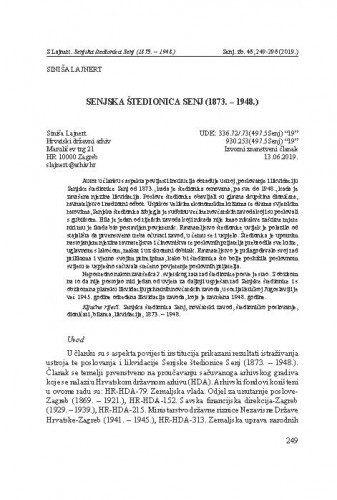Autor u članku s aspekta povijesti institucija obrađuje ustroj, poslovanje i likvidaciju Senjske štedionice Senj od 1873., kada je štedionica osnovana, pa sve do 1948., kada je završena njezina likvidacija. Poslove štedionice obavljali su glavna skupština dioničara, ravnateljstvo i nadzorni odbor. Usprkos velikim ekonomskim krizama te dvama svjetskim ratovima, Senjska štedionica izbjegla je sudbinu većine novčarskih zavoda koji su poslovali s gubitkom. Bila je jedan od rijetkih zavoda koji nikada nije imao nikakve zaštitne mjere niti mu je ikada bio postavljen povjerenik. Ravnateljstvo štedionice uvijek je polazilo od stajališta da prvenstveno treba očuvati zavod, u čemu se i uspjelo. Štedionica je upornim nastojanjem njezina ravnateljstva i činovništva te poslovnih prijatelja prebrodila sve krize, uglavnom s lakoćom, makar i uz skromni dobitak. Ravnateljstvo je prilagođavalo svoj rad prilikama i vjerno svojim principima, kako bi štedionica što bolje poslužila poslovnom svijetu te uspješno sačuvala stečeno povjerenje poslovnih prijatelja. Neposredno nakon završetka 2. svjetskog rata rad štedionice posve je stao. S obzirom na to da nije postojao niti jedan od uvjeta za daljnji uspješan rad Senjske štedionice i s obzirom na plansku likvidaciju privatnih novčarskih zavoda, u socijalističkoj Jugoslaviji je već 1945. godine određena likvidacija zavoda, koja je završena 1948. godine.; In the article, the author, from the aspect of the history of the institution, deals with the business and liquidation of the Senj savings bank from 1873, when the savings bank was founded, all the way to 1948, when its liquidation was completed. The business affairs of the savings bank were carried out by a main assembly of shareholders, a directorate and supervisory board. Despite the large economic crises and two world wars, Senj’s savings bank avoided the fate of the majority the financial institutions that operated with a loss. It was one of the rare institutions which never had any kind safeguards nor was it ever appointed with a commissioner. The directorate of the savings bank always began from the standpoint that the institution should primarily be preserved, which is what it succeeded in. With the sturdy determination of its directorate and clerical service and business friends, the savings bank overcame all crises, generally with ease, if only with a modest profit. The directorate adapted its work to the circumstances and faithfully to its principles, in order for the savings bank to better serve the business world and successfully preserve the gained trust of its business friends. Immediately after World War Two, the work of the savings bank completely stopped. Given that there was not one condition for the further successful work of the Senj savings bank and given the planned liquidation of private financial institutions, in socialist Yugoslavia, the liquidation of institutions was specified as early as 1945, and it was completed in 1948.
Sažetak

 Senjski zbornik : prilozi za geografiju, etnologiju, gospodarstvo, povijest i kulturu : 46(2019).
Senjski zbornik : prilozi za geografiju, etnologiju, gospodarstvo, povijest i kulturu : 46(2019).